Are you looking for the best framing nails? Well, there would be times in your life when doing DIY framing jobs is the best option over hiring a professional. Thus, having a solid understanding of nail sizes is pivotal when you decide to pull up your sleeves and do the dirty work.
And in the midst of this quandary, you might come across another challenge, and that is choosing between 3 1/4 or 3 1/2 framing nails. To help you out, we have prepared this guide so you’ll learn all the key points about these common construction tools.
But before we get started, it’s important that you understand the importance of nails in general. In the construction industry, nails are popular fasteners mainly utilized for structural joining. Power tool specialist Jim Boslice from thejimbosliceworkshop.com says, these are pivotal in installing hardwood floors, roof decking, securing plywood sheathing, and framing projects.
Moreover, there are various types of nails, each with different usage and its own way of application. Therefore, if you’re doing the construction on your own, comprehending the basics is crucial for structural safety and efficiency. The penny system, for one, is a vital term when buying nails in the US.
This sizing system generally uses the traditional English penny abbreviation, which is “d”. So, for instance, a 16-penny nail is known as 16d while a 12-penny nail is 12d. In this guide, we will focus on these two nail sizes and provide an in-depth analysis as well as a blow-by-blow comparison of all their features and costs.
What are 3 ¼ Framing Nails?

In comparison to a 3 ½ inch nail, a 3 ¼ inch nail or 12d is a smaller nail by ¼ inch. But despite their short size, these smaller nails are the best option if you’re using a nail gun. Nail guns are relevant construction machinery that drives the nails mechanically into the surface.
This automatic hammer is useful in building furniture, creating decks, and installing roof materials, among others. When using this tool, you need to take into account the nail size. It’s because the efficiency of the nail gun highly depends on the features of the nail, including the head diameter and shaft thickness.
Therefore, you should make sure that the nail fits the specific length of the nail gun. More than that, choosing the right length is crucial for its efficiency and longevity. And when it comes to nail guns, most contractors would suggest using 3 ¼ inch nails.
These nails are very functional, especially if you’re planning to do some light construction activities or repairs on your own. Since most nail guns use 3 ¼ inch nails, you won’t have a hard time building simple projects where the structural foundation isn’t very crucial.
Although structural integrity is vital in construction, there are creations that aren’t as weighty as residential homes or commercial properties. For instance, if you’re creating pet houses, sheds, pump houses, and the like, 3 ¼ inch nails are recommended.
These nails can also be utilized for interior framing of non-load-bearing walls or walls that only carry their own weight. Thus, if you prefer some DIY constructions using a nail gun, the best nails would be those with smaller size shanks, or simply 3 ¼ inch nails.
And while 3 ¼ inch nails are suitable for nail guns, these can also be maximized for hand driving. You just need to be more focused when hammering the nails because these are smaller in size.
What are 3 ½ Framing Nails?

Now that you understand what a 3 ¼ inch nail is, it’s time to move to the next nail size. A 3 ½ inch nail or 16d nail is often the most recommended size when it comes to framing or fitting together building materials to build a structure and shape.
These particular nail sizes seamlessly connect framing materials such as hardwood and engineered wood, along with drywall, concrete, plastic, and masonry. In general, the 3 ½ inch long nails are the best choice when using a hammer because of their length and durability.
With its size and sturdy features, it is primarily used in creating structural support, from trusses to subfloors. This kind of nail is also effective for wall sheathing, specifically connecting exterior walls and other exterior framing applications.
Aside from these core characteristics, it’s pivotal to know that there are actually two types of 3 ½ inch nails. So, when buying a 3 ½ nail from your local hardware stall, you’ll be asked whether commons or sinkers.
To help you distinguish the two, we will discuss the main difference between these two nail types. Let’s kick off with common nails.
Common Nails
Common nails have bigger diameters with smoother and wider heads. Its diameter generally settles around 0.162 inches, which means it’s quite visible on the surface. More so, this specific nail type supports heavier structural loads.
Because of their sharper point and heavier shaft, the nails can easily get through thicker wood without ruining the fiber that causes the wood to split. These major characteristics make common nails the most appropriate choice for general construction.
Sinker Nails
Meanwhile, sinker nails are thinner with a flat and smaller head, making them easy to hammer down and slide into the wood smoothly. Compared to common nails, sinkers have a diameter of 0.148-inch and are often layered with vinyl cement or epoxy coating to protect them from unwanted moisture.
More so, sinkers come with textured tips. This specific feature creates a smoother manner of driving the nail into the surface and sliding into the wood. The textured head also provides a better grip when hammering the nail. Thus, sinkers are very manageable when it comes to driving one nail after the other.

What are the Differences Between 3 1/4 and 3 1/2 framing nails?
After learning the ins and outs of both 3 ¼ inch and 3 ½ inch framing nails, let’s now focus on comparing the two. This is vital to give you a clearer view of their key features as well as major differences. More so, the comparison below will greatly help you choose the best nails for your framing needs.
Accordingly, picking the right nail size and type means saving money, time, and effort from substandard work. Thus, you need to fully comprehend the technicalities for you to easily and effectively select the most suitable nail size based on your needs.
So, for the first comparison, we have the prices of the nails. Do take note that the price is based on brands with the most reviews from Amazon. Also, the cost listed is per box and not per piece. And aside from the base price, there may be other fees to consider if you’re living outside the United States.
Henceforth, it’s recommended that you purchase from your hardware store to save money. Buying from a local shop also allows you to ask questions from the clerk, especially if you are unsure of what to choose.
1. Cost
- 3 ¼ ― $ 17.44 (400 pcs. per box)
- 3 ½ ― $37.35 (500 pcs. per box)
2. Key features of a 3 ¼ nail
- Shorter and slimmer shaft size
- Smaller head diameter
- Ideal for nail guns
- Great for framing exterior walls
- Suitable light constructions and repairs
- Recommended for simple DIY framing
3. Key features of a 3 ½ nail
- Longer and thicker shaft size
- Just enough head diameter size
- More durable and effective for framing
- Complements well when using a hammer
- A great choice when it comes to interior framing
- Highly recommended for the construction of structural support
So, if you’re still undecided…
Choose 3 ¼ nails: if you are working on simple home constructions like creating wooden crates for your pets or building a pump house for a well. This is also the best option when it comes to framing the exterior of your walls, which requires a nail that would do its job while also not very visible to the naked eye.
Lastly, this is the most recommended choice if you have a nail gun that fits this particular size. Using a 3 ¼ nail for a nail gun gives you so much efficiency in your work without ignoring its quality.
Choose a 3 ½ nail: if you are building a structure that would need a solid foundation, perhaps houses and buildings. Since this has a thicker and longer shaft, it is very much effective when connecting framing materials like wood, plastic, concrete, and such.
The durability of the nail also makes it ideal for framing the interior walls of your home. More so, the head diameter and the shaft are not too big or too long, so it would not ruin the surface. Because of these features, this nail size is the finest option among contractors.
Conclusion
To wrap it all up, both 3 ¼ inch and 3 ½ inch framing nails may not be effective if you don’t follow some relevant techniques. First, make sure you don’t put all nails on the same grain line. Second, blunt the nails to ensure a smooth entry of nails.
The third and fourth tips are angling your nails and avoiding edges. Lastly, don’t forget to have spare nails because you’ll never know if you’ll experience bent nails during your work.
And with the relevant information above, we hope that you get a gist of how to choose between 3 1/4 or 3 1/2 framing nails. So, the next time you head to your local hardware store, you’ll be knowledgeable and certain about your choices.

